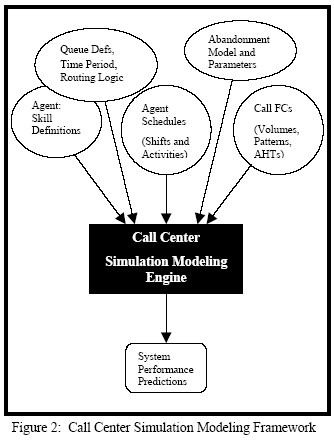|
|
DSC Tech Library
 This section of our technical library presents information and documentation relating to Call Center technology and Best Practices plus software and products.
DSC is a leading provider of contact center technology and software solutions as well as predictive dialer phone systems for the modern call center. Customer contact center software includes CRM software and computer telephony integration solutions. These modern products help call center phone agents communicate effectively with your customers and prospects.
This section of our technical library presents information and documentation relating to Call Center technology and Best Practices plus software and products.
DSC is a leading provider of contact center technology and software solutions as well as predictive dialer phone systems for the modern call center. Customer contact center software includes CRM software and computer telephony integration solutions. These modern products help call center phone agents communicate effectively with your customers and prospects.
The following article presents product or service information relating to call centers and customer service help desks.
Call Center Simulation Modeling:
Methods, Challenges, And Opportunities
Page 3
By Vijay Mehrotra, Department of Decision Sciences
College of Business - San Francisco State University
Jason Fama, Engineering Group, Blue Pumpkin Software Inc.
In each of these cases, the key output statistics typically
include the some or all of the following metrics:
- Queue Statistics: The two dominant queue statistics
for inbound queues and call centers are Average
Speed of Answer (“ASA”) and Percent of
Calls Answered with a queue time of less than
some defined value (“PCA” or, more commonly,
“Service Level).” Note that for each queue this
statistic is interesting at the interval level (typically
15 minutes, 30 minutes, or one hour) and
also at the aggregate daily and weekly levels; additionally,
management is interested in the overall
performance across a collection of queues that
draw upon a common pool of agent resources.
- Abandonment Statistics: For most inbound call
centers, particularly those focused on customer service
and/or sales, a great deal of attention is paid to
the overall number of customers who abandon (that
is, hang up and thus leave the queue before being
served). This is known to be a significant indicator
of customer satisfaction (see Feinberg et al. 2000
for a recent published study on this). Many centers
will look at the more restrictive metric of number
of customers abandoning beyond the target Service
Level parameter, based on the rationale that a certain
waiting time in queue (as defined by the Service
Level parameter, which ranges from 5 seconds
to several minutes across companies and industries)
is inevitable.
- Volume Statistics: For outbound queues and call
centers, the real statistic of interest is Right Party
Connects (“RPCs”). That is, for all of the attempted
calls that were made, what percentage of
these calls reached the targeted individual (as opposed
to no answer, answering machine, or some
other human being). Outbound contact center
managers are typically interested in RPC on both
an absolute and a percentage basis. For inbound
queues, the Calls Handled statistic is of interest,
and is easily derived by subtracting Abandoned
Calls from the total number of incoming calls (referred
to as “Offered Calls”).
4 CALL CENTER SIMULATION MODELLING
4.1 Framework
The biggest challenge of call center simulation modeling is
the definition and organization of model inputs. Figure 2
below illustrates our framework for call center simulation
model definition and key inputs.
As reflected in Figure 2, call center simulation models
feature a diverse range of inputs from multiple data
sources, and as with all simulation designs, there are decisions
to be made about the level of detail to include in the
model.

In the sections below, we discuss these key input areas
in more detail. In the process, we will use our example
model to illustrate these modeling concepts.
4.2 Key Inputs: Queue Definitions, Time
Period, and Routing Logic
The basic building blocks of a call center simulation model
are the calls, the agents, and the time period during which
the call center is open. In turn, the basic routing logic
connects the way that the calls interact with the people during
that time period.
Typical call center simulation models contain more
than one queue (as single queue models are ordinarily dealt
with analytically) and run for a period of one day, one
week, or multiple weeks.
Our example model is for a Collections call center. As
is typical for call centers, this operation is part of a larger
business context, in which creditors’ records are being
monitored on a regular basis for potential delinquency.
Once a customer falls into delinquency, several things
happen: (a) the information on the account is added to a list
of prospects for an Outbound collections call; (b) they are
notified about the state of their credit by mail; and (c) additional
limitations may be placed on the account.
Page
[1]
[2]
3
[4]
[5]
[6]
[7]
[8]
Next Page
|


 This section of our technical library presents information and documentation relating to Call Center technology and Best Practices plus software and products.
DSC is a leading provider of contact center technology and software solutions as well as predictive dialer phone systems for the modern call center. Customer contact center software includes CRM software and computer telephony integration solutions. These modern products help call center phone agents communicate effectively with your customers and prospects.
This section of our technical library presents information and documentation relating to Call Center technology and Best Practices plus software and products.
DSC is a leading provider of contact center technology and software solutions as well as predictive dialer phone systems for the modern call center. Customer contact center software includes CRM software and computer telephony integration solutions. These modern products help call center phone agents communicate effectively with your customers and prospects.
